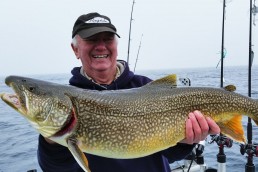Lake Michigan Trout
SHARE THIS POST
Lake Michigan has been a “put-and-take” trout and salmon fishery since the first stockings were done more than 50 years ago. For the most part, it still is.
As anglers, we have always been able to keep fish as were needed, because they were always planting more. Well, that time has come to an end with the recent decreases in brown trout stocking. The brown trout is a bread-and-butter species for shore fishermen. As other trout and salmon species come and go throughout the year, the brown trout is our near-shore homebody that provides us action 12 months out of the year.
Put ‘em back, catch ‘em later
So, as shore anglers, I think it’s time to start to preserve the trout that they are stocking if we want to have anything close to the world-class brown trout fishery we have enjoyed for the past half-century. The time has come for catch-and-release on Lake Michigan.
I want to go through some tips for catch and release of these magnificent fish so they can continue to grow to the enormous proportions that we have become accustomed to. Remember, the salmon lifecycle is four years. The trout will live and continue to grow well beyond that if we practice some selective catch and release.
Catch-and-release tackle
First, let’s talk rods and line. As incredibly fun as it may be to hook a big brown on 4-pound test and a 12-foot noodle rod, the length of time it takes to land a double-digit fish on that tackle is pure exhaustion to the fish. While you can’t really use line much heavier than about 10-pound test, most browns and rainbows can be landed in a very reasonable amount of time with 8- or 10-pound line. It also reduces the risk of breaking off trout and letting it swim off with gear in its mouth. Unless you are pursuing a new record for 4-pound line, stick with 8- or 10-pound test.
Second, let’s talk hooks. Not too much with lures, but live-bait rigs. Soaking alewives on a bottom rig in late June and July can be very effective for giant browns. The danger here is gut-hooking a big brown during the most stressful time of the year for them. The answer is circle hooks. If you don’t already use circle hooks for presenting live alewives, now is the time to start. Circle hooks are specifically designed to pass through stomachs and throats and hook fish in the corner of the mouth.
Since I started using them myself about 10 years ago, I can only remember one or two times that the fish was not hooked cleanly in the corner of its mouth. If you want to start using circle hooks, look for a non-offset, light-wire circle hook in the #1, or #1/0 size for small alewives and #3/0 for big-daddy summer alewives. The size #1 are also good for spawn-sack fishermen. My favorite is Mustad’s Demon Perfect Circle hook (39951NP-BN).
Putting them back alive
The trick to a circle hook is letting the hook do its thing. Don’t set the hook! The hook will set itself. When the trout takes the bait, just start reeling and the hook will find a safe home in the corner of the mouth where it can be easily removed.
One last tackle tip is a proper-size net. Trout jammed in a small net will cause all kinds of damage, including damaged fins and gills and increased time out of the water. The proper net should be 30 to 36 inches in diameter, with a deep bag that will cradle the fish during landing and release. Shoving a piece of PVC pipe into a “bass net” is not a good choice for properly landing a big trout.
Now, it’s all about fish handling. The biggest factor in the mortality of fish trying to be released is poor handling.
Are you enjoying this post?
You can be among the first to get the latest info on where to go, what to use and how to use it!
Handling can be two different factors. One is the general term of “handling”… the full procedure in the release. The other is the literal physical handling of the fish. Like any fish, and especially these enormous browns, they have to be held horizontally. These fish are way too large and way too delicate to be grabbed by the gill covers and hung vertically. Muskie fishermen have perfected this technique, and giant browns are no exception. I personally like to grab the trout by the base of the tail with one hand and then support the head area with the other hand. The base of the tail is a good control point, and the support hand doesn’t squeeze any vital organs. Keep your fingers away from eyes and gills.
Limiting time out of the water
The rest of “handling” is the procedure. Limiting the time out of the water is critical. Preparation is the key!
For starters, your hook-removal pliers should be on you at all times. The time to start looking for your pliers is not when the fish is flopping around on the pier. Designate a pocket where you know that your pliers will always be.
We all like to record our catch, and measuring a length and girth are a perfect way to see what the trout weighs. Length x girth x girth /800 calculates the weight of a Lake Michigan salmonid incredibly close. A recoiling tape measure is great, but they are heavy and bulky. I prefer a cloth or vinyl tape like what is used by dressmakers. They roll up in a tight coil and fit into a pocket with ease. They are also easy to wash off and don’t rust. The key is keep it with you! Don’t look for it when the fish is on the deck.
Take the memories, leave the fish
We all like to take a photo of our catch and, with the great cellphone cameras out there, this has never been easier. If you have a buddy with you, they should be getting the camera ready while you are unhooking, Plan the shot, light in your face, or hide a background if that is important to you.
If you are alone, this is more difficult but can be done. Most cellphones have a 5- or 10-second self-timer and a selfie mode. Make sure before you start fishing that both of these are set properly. Next is knowing where you will set the camera for the shot. I highly recommend one of the flexible tripods with a cellphone clamp like the Joby Gorilla Pod or one of the recent knockoffs of the same system. If I am fishing alone, I will set up my phone on the Gorilla Pod before I even start and put it in my tackle bag, all set to go.
When you have a partner along, once the fish is in the net, the net man should keep the fish in the water until the angler has everything ready before they bring the fish on land.
Release technique
Once the fish is landed, unhooked, measured and photographed, it’s time to release. If you are close to the water (3 feet or so), you can simply aim the fish, head first and slide it back in the water. If you are high off the water, it’s better to get the fish back in the net and lower it back into the water. In the cold-water months, the fish will generally release strong and easy. It’s the summer months when they will need a little more TLC. In summer, at times, they will want to sit belly up. You may need to use the net to right them long enough for them to regroup and get their bearings. This can take 10 to 15 minutes at times, so be patient. In winter, remember that eyes and gills can freeze quickly. Watch your time!
Due to stocking reductions to the shore fisherman’s primary catch, the brown trout, we will need to show some conservation. If you need a fish for the smoker, keep a salmon. I’m not saying that you can never keep a brown, but think about taking a picture and releasing it to become a 30-pounder someday. We have one of the greatest trout fisheries in the world here. Until we go back to stocking the right numbers of trout, we will need to conserve.
MWO
SHARE THIS POST
Did you enjoy this post?
You can be among the first to get the latest info on where to go, what to use and how to use it!
Marc Wisniewski
Marc Wisniewski is an avid Wisconsin angler specializing in Lake Michigan shore and inshore fishing. He also chases bass, pike, and muskies anywhere he can. He has built custom rods for 35 years and makes lures from wood, lead and soft plastics. Wisniewski has been writing fishing articles for more than 30 years.



